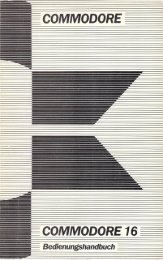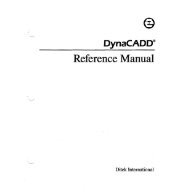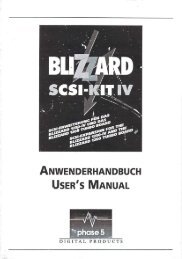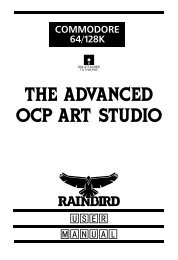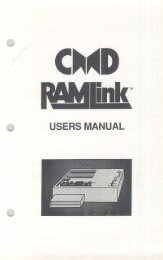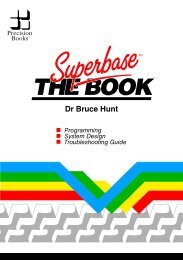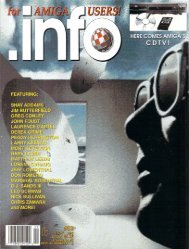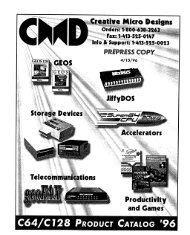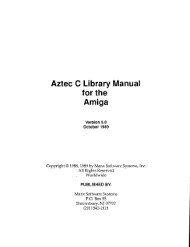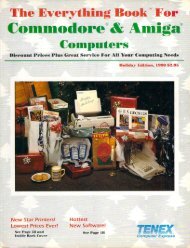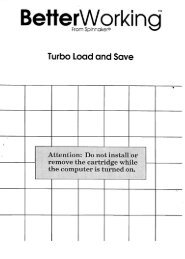Create successful ePaper yourself
Turn your PDF publications into a flip-book with our unique Google optimized e-Paper software.
STRIKE UP THE BAND—<br />
attiiga TJJusic: Tfje State Of Tbe art<br />
Making music on a traditional instrument<br />
requires a major investment to develop one's<br />
chops or manual dexterity. You can do that on<br />
an electronic instrument, too, if you insist, but<br />
the real advantage of a newfangled musicmaker<br />
is that you don't have to practice<br />
forever to get musical satisfaction.<br />
Making music on the Amiga is especially easy<br />
because it's a powerful computer coupled with<br />
a flexible, high-quality musical instrument.<br />
Thanks to computer memory and software,<br />
making music is a two-step process, with time<br />
on your side for a change. For most of it,<br />
you'll work one step away from the final<br />
outcome, entering notes at your leisure with<br />
the mouse or slowly playing them into memory<br />
on an attached piano-type keyboard. This is<br />
possible because unlike acoustic sound,<br />
electronic sound is produced in two distinct<br />
parts, pitch being one, and timbre or the<br />
nature of the sound being the other, so that<br />
changing one doesn't alter its counterpart.<br />
Electronic music can be played faster without<br />
altering the pitch, and parts that were entered<br />
separately can be played back together without<br />
any loss of quality. Once you've entered the<br />
notes, the instruments playing various parts<br />
can be swapped until you're satisfied with the<br />
arrangement.<br />
NOTE EDITORS & SEQUENCERS<br />
Although standard music notation isn't<br />
capable of reflecting much that electronic<br />
music-makers can do, it is used in computer<br />
music programs because nobody has come up<br />
with an acceptable alternative. These programs<br />
are commonly, but not always, called note<br />
editors. This capability means that after<br />
you've entered the music, the program provides<br />
a means of altering pitch and duration, and<br />
moving or copying notes alone or in groups,<br />
and a good note editor can save you a lot of<br />
work. All of the programs described here have<br />
note> editors, though one of them, ProMIDI<br />
Studio, uses numbers instead of standard music<br />
notation. Note editors also incorporate some<br />
of the functions from what was the original<br />
software music manipulator, the sequencer.<br />
f 56 '<br />
—*i - —^<br />
1IIHII1IIIIIII1I i<br />
by Hcrrit^ton<br />
t<br />
A sequencer lets you do much more than<br />
copy or paste and add first and second endings,<br />
which are the features most commonly<br />
borrowed by note editors. It saves groups of<br />
notes in separate sections and lets you set them<br />
up to play in unlimited combinations, AABA<br />
or ABABC, for example. A sequencer doesn't<br />
use much computer memory because rather<br />
than actually rewriting sections in the proper<br />
order, internal pointers are used to indicate<br />
which part gets played when. Complex scoring<br />
can be arranged with a sequencer, as musicians<br />
familiar with the fugue will appreciate<br />
immediately. I don't know how true it is, but<br />
a college professor of mine claimed that J.S.<br />
Bach -the master of the fugue- had written<br />
more music than the average person today<br />
could copy by hand, working eight hours a<br />
day, five days a week during his entire<br />
working life. It boggles the mind to think<br />
what he could have done with ProMIDI Studio,<br />
the only program mentioned here that has both<br />
a sequencer and note editor.<br />
IFF COMPATIBILITY<br />
Music software is available on all kinds of<br />
personal computers, but Amiga program<br />
developers are working on something that's a<br />
first in the industry. Graphics and music<br />
developers are trying to put the data produced<br />
by their programs into a standardized format<br />
'so that it can be used with their competitor's<br />
products. It's called the Interchange File<br />
Format (IFF for short) and so far the graphics<br />
artists are ahead of the musicians which is,<br />
interestingly enough, the way it's been down<br />
through the ages. (Digital sampler makers arc<br />
in on the act, too, sec Info #13 for details.) It<br />
should be worth the wait because once the<br />
rough edges and transitions are smoothed out<br />
(and actually, there aren't that many left),<br />
Amiga musicians will be able to enter a<br />
composition with the program of their choice,<br />
edit and arrange it with another they think<br />
better suited, print out sheet music with a<br />
third, and synchronize video images to it with<br />
a fourth.<br />
Here are the programs which promise that<br />
power.<br />
J



